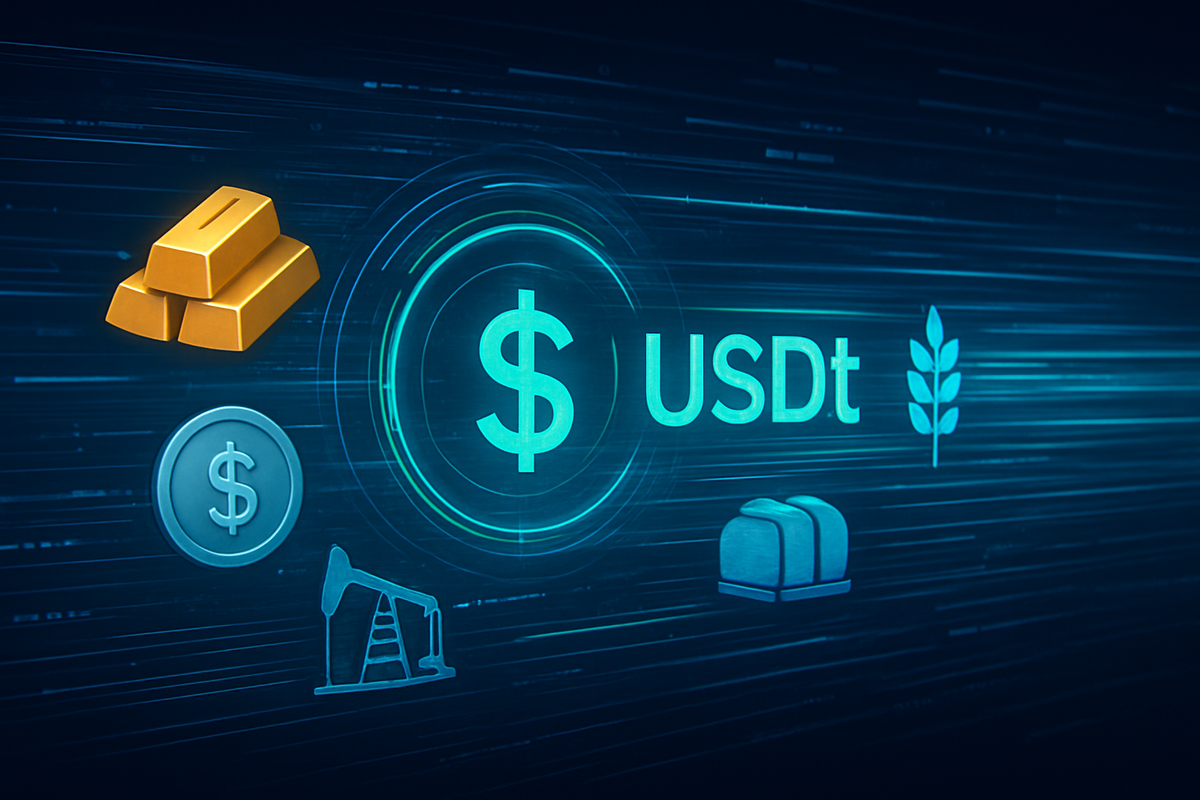
Tether (USDT), the issuer of the world's largest stablecoin, USDt, has embarked on a groundbreaking venture, deploying an initial $1.5 billion into commodity trade lending. This strategic move, which aims to expand to $3-5 billion by 2026, leverages the speed and efficiency of USDt to offer faster, high-yield loans, directly challenging the traditional banking sector's dominance in trade finance. This bold initiative is poised to revolutionize global financial mechanisms and significantly impact precious metal markets by enhancing liquidity and potentially driving demand. The investment signals a significant pivot for digital assets, moving beyond speculative trading into tangible, real-world economic applications, and could redefine the future of global commerce.
The immediate implications are profound: a new, agile player has entered the often-staid world of commodity finance, promising to fill a credit gap left by traditional banks. This could unlock capital for a wider array of trading firms, particularly in emerging markets, while also accelerating the digital transformation of finance. For precious metals, Tether's existing strong presence, coupled with this new lending strategy, could further integrate crypto and traditional markets, potentially influencing gold and silver prices and accessibility.
Tether's Ambitious Foray: Specifics, Timeline, and Market Response
Tether's strategic entry into commodity trade lending is managed through its dedicated "Trade Finance unit," also known as "Tether Investments." This unit operates independently of Tether's stablecoin reserves, funded instead by the company's substantial profits, which are projected to reach an impressive $15 billion in 2025. The lending targets a broad spectrum of traditional commodities, including essential agricultural products like cotton and wheat, as well as critical energy resources such as oil and natural gas. Initial discussions for this ambitious venture commenced in October 2024, culminating in the successful financing of the first crude oil transaction in November 2024, marking a swift transition from concept to execution.
The core innovation driving Tether's strategy is the utilization of USDt to facilitate these loans. While financing options are available in both traditional US dollars and USDt, the stablecoin offers distinct advantages that are set to disrupt conventional trade finance. USDt transfers can settle in mere minutes, a critical factor in volatile commodity markets where traditional bank loans often languish for days or even weeks. This near-instant settlement capability significantly accelerates cargo movements and mitigates risks associated with rapid price fluctuations, providing a crucial edge for traders.
Furthermore, USDt-based loans offer the benefit of reduced costs and fewer barriers. By circumventing the often-complex, bureaucratic, and costly processes of traditional banking, Tether streamlines access to working capital. This is particularly beneficial for smaller trading firms and those operating in emerging markets, where USDt is already a widely accepted medium for cross-border payments. Tether's objective is to generate substantial interest income by providing much-needed liquidity to a commodity sector that is perpetually in demand for financing. The company has also strategically hired senior metals trading executives from HSBC (HSBC), signaling its intent to deeply integrate cryptocurrency finance with traditional precious metals markets and exert greater influence over the movement, storage, and trading of bullion.
Initial market reactions, though still developing, indicate a mix of anticipation and scrutiny. Traditional financial institutions are likely to view this as both a competitive threat and a potential catalyst for their own digital asset strategies. For commodity traders, especially those struggling with conventional financing bottlenecks, Tether's offering presents a compelling alternative. The move also underscores a broader trend of stablecoin issuers seeking to deploy their vast reserves and profits into real-world, yield-generating assets, moving beyond just maintaining peg stability.
Market Winners and Losers: A Shifting Landscape
Tether's $1.5 billion pivot into commodity trade lending is poised to create clear winners and losers across the financial and commodity sectors.
Potential Winners:
- Commodity Trading Firms (especially SMEs and those in emerging markets): These firms often face significant hurdles in securing timely and cost-effective financing from traditional banks due to stringent regulatory requirements and risk aversion. Tether's USDt-backed loans offer a faster, more efficient, and potentially less bureaucratic alternative, providing crucial working capital that can accelerate trade cycles and enhance operational flexibility. This could democratize access to finance in the commodity sector, fostering growth in previously underserved regions.
- Tether (USDT) and its Investors: By deploying its substantial profits into high-yield commodity trade lending, Tether diversifies its revenue streams beyond stablecoin issuance. This move allows the company to generate significant interest income, further bolstering its financial strength and potentially increasing its profitability, which in turn could benefit its stakeholders.
- Blockchain and Digital Asset Infrastructure Providers: The increased adoption of USDt for real-world trade finance will drive demand for robust blockchain infrastructure, secure digital wallets, and efficient cross-border payment solutions. Companies specializing in these areas stand to benefit from the expanded use cases of stablecoins.
- Precious Metal Holders and Miners: Tether's continued accumulation of physical gold and its strategic integration into commodity markets, including the hiring of metals trading experts, signals a long-term commitment to the sector. This could translate into sustained demand for physical gold (XAU), potentially supporting or increasing its market price. Miners like Barrick Gold (NYSE: GOLD) or Newmont Corporation (NYSE: NEM) could see a more robust demand environment for their output.
Potential Losers:
- Traditional Banks (especially those in Trade Finance): Established banks, such as JPMorgan Chase (NYSE: JPM) or BNP Paribas (EPA: BNP), which have historically dominated commodity trade finance, face a direct and formidable competitor. Many have already scaled back their involvement in this sector due to increased regulatory burdens (e.g., Basel III capital requirements), risk aversion, and past fraud cases. Tether's agile, digital-first approach threatens to erode their market share and pressure them to innovate or risk becoming less relevant in this lucrative segment.
- Legacy Financial Infrastructure Providers: Companies that rely on outdated, slow, and expensive interbank messaging and settlement systems may see reduced demand as faster, blockchain-based alternatives gain traction.
- Small, Less Innovative Stablecoin Issuers: While Tether's success might inspire other stablecoin issuers, those without the capital, market penetration, or strategic vision to enter real-world lending may find themselves struggling to compete or differentiate their offerings, potentially leading to market consolidation.
The impact on public companies will vary. For instance, companies heavily involved in global trade, such as shipping lines or large commodity houses, might find new financing avenues, potentially lowering their operational costs and improving their capital efficiency. Conversely, traditional financial institutions that fail to adapt to this new paradigm could see their trade finance revenues diminish, impacting their bottom line and potentially their stock performance.
Wider Significance: Reshaping Global Finance and Regulatory Horizons
Tether's audacious leap into commodity trade lending is far more than just a new investment; it represents a significant inflection point that could fundamentally reshape global finance and digital asset adoption. This event aligns perfectly with broader industry trends emphasizing the tokenization of real-world assets (RWA) and the increasing utility of stablecoins beyond speculative trading. It underscores a growing recognition within the crypto space that true disruption lies in solving tangible economic problems with blockchain technology.
The potential ripple effects on competitors and partners are substantial. Other major stablecoin issuers, such as Circle (USDC), are likely to closely observe Tether's success and may be compelled to explore similar ventures. This could ignite a "stablecoin lending race," fostering innovation but also intensifying competition for market share in various real-world asset classes. Traditional financial institutions, already grappling with digital transformation, might accelerate their efforts to integrate blockchain solutions or forge partnerships with crypto firms to remain competitive in trade finance. Fintech companies specializing in cross-border payments and supply chain finance could also find new opportunities for collaboration or face heightened competition from agile, crypto-native players.
From a regulatory standpoint, Tether's expanded use of USDt in cross-border trade finance will undoubtedly draw increased scrutiny. Regulators worldwide are already grappling with how to classify and oversee stablecoins, and their deeper integration into critical economic functions like trade finance will necessitate clearer frameworks. Discussions around anti-money laundering (AML), know-your-customer (KYC) standards, consumer protection, and systemic risk will intensify. This could lead to the development of new, more comprehensive digital asset regulations, potentially creating a more structured, albeit potentially more restrictive, environment for stablecoin operations globally. The ongoing debate around central bank digital currencies (CBDCs) might also be influenced, as the private sector demonstrates effective, large-scale digital currency use cases.
Historically, the evolution of trade finance has always mirrored technological advancements, from the invention of bills of exchange to the advent of SWIFT. Tether's move can be compared to past innovations that streamlined global commerce, such as the introduction of electronic letters of credit. While not entirely unprecedented in its goal of faster, cheaper finance, the method—leveraging a decentralized, permissionless (or at least less permissioned) blockchain for large-scale, high-value commodity transactions—is revolutionary. It harks back to the early days of globalization where innovative financial instruments facilitated trade across vast distances, but now powered by 21st-century digital rails. This paradigm shift could accelerate the decentralization of financial power, moving it away from a few large, centralized entities towards a more distributed and efficient model.
What Comes Next: Navigating a New Financial Frontier
Tether's bold $1.5 billion investment into commodity trade lending marks the beginning of a transformative era, with both short-term and long-term implications that will reshape the financial landscape.
In the short term, we can expect to see an accelerated adoption of USDt in commodity trading circles, particularly among firms seeking to bypass the often-cumbersome processes of traditional banking. This immediate influx of liquidity could provide a much-needed boost to global supply chains, enabling faster transactions and reducing the working capital cycles for traders. Competitors, both within the stablecoin space and traditional finance, will likely scramble to assess Tether's model. Other stablecoin issuers may attempt to replicate this strategy, while traditional banks might explore partnerships with blockchain firms or develop their own tokenized finance solutions to retain market share. We could also see an immediate impact on the demand for physical gold, as Tether's continued accumulation and integration into trade finance solidifies its role as a significant player in the precious metals market.
Looking into the long term, the potential for systemic change is immense. If Tether successfully scales its lending operations to $3-5 billion by 2026, it could establish a new norm for trade finance, where digital assets are integral to global commerce. This could lead to a broader "tokenization of everything," where various real-world assets are represented on blockchains, facilitating more efficient and transparent markets. Strategic pivots will be crucial for all stakeholders. Traditional banks will need to either fully embrace digital asset solutions or find niche areas where their existing infrastructure retains an advantage. Commodity trading firms will need to adapt their operational procedures to leverage the speed and efficiency of stablecoin-based financing.
New market opportunities will emerge, including specialized blockchain platforms for trade finance, advanced risk management tools for digital asset lending, and new derivatives markets based on tokenized commodities. Challenges will include navigating evolving regulatory landscapes, managing the inherent volatility of cryptocurrency markets (even for stablecoins, the underlying collateral can be subject to market fluctuations), and ensuring robust security against cyber threats. Potential scenarios range from a gradual integration of digital assets into existing financial structures to a more radical overhaul where blockchain-native solutions become the dominant force in trade finance. The success of Tether's venture could also pave the way for other stablecoins or even CBDCs to play a more active role in cross-border payments and lending, creating a truly global, digital financial ecosystem.
A New Dawn for Global Trade Finance: Summary and Outlook
Tether's revolutionary $1.5 billion investment in commodity trade lending, powered by USDt, represents a pivotal moment in the convergence of digital assets and traditional finance. The core takeaway is clear: stablecoins are moving beyond their role as mere crypto trading pairs and are now poised to become fundamental instruments in real-world economic activity. By offering faster, high-yield loans and filling a critical credit gap left by traditional banks, Tether is not just innovating; it's actively reshaping the infrastructure of global trade finance. This initiative underscores the immense potential of blockchain technology to enhance efficiency, reduce costs, and democratize access to capital for commodity trading firms worldwide.
Moving forward, the market will be closely watching several key indicators. The pace and scale of Tether's loan deployments will be crucial, as will the uptake from commodity traders. Any challenges related to regulatory compliance, security, or the stability of the USDt peg in the face of expanded utility will also be critical to monitor. The reactions of traditional financial institutions and their subsequent strategic adjustments—whether through competitive offerings, partnerships, or lobbying for new regulations—will define the evolving competitive landscape.
The lasting impact of this event could be profound. It may accelerate the broader institutional adoption of stablecoins, drive further innovation in blockchain-based financial products, and ultimately lead to a more interconnected and efficient global financial system. For investors, the coming months will offer a fascinating case study in how digital assets can disrupt established industries. Watch for further announcements from Tether, responses from major banks, and any new regulatory guidance that emerges. The interplay between these forces will determine whether Tether's gamble truly revolutionizes global finance or merely serves as a powerful catalyst for change.
This content is intended for informational purposes only and is not financial advice






